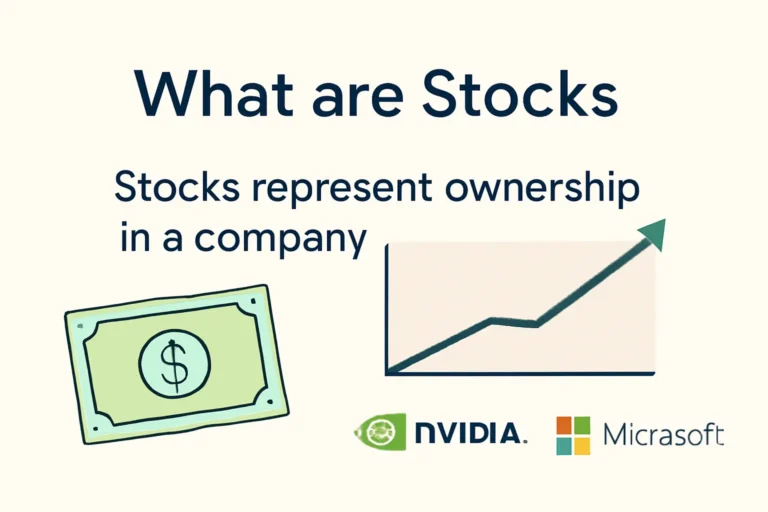
What Are Stocks? 3 Ways to Build Wealth Through Ownership and Smart Investing
Part 1: What are Stocks? Explained Simply
Imagine owning a slice of your favorite company. That’s exactly what a stock allows you to do.
In simple terms, a stock is a share of ownership in a company. When you purchase a stock, you own a portion of that business and have a claim to its profits and assets. You are not just buying a piece of paper or a digital record—you are becoming a shareholder.
Let’s say you own 1 share of Apple. That means you literally own a fraction of Apple Inc., no matter how small. This entitles you to participate in the company’s success, including dividends, and potentially see your share value grow over time.
Here’s a simple analogy: Imagine a company as a giant pizza. If the company has 100 shares, and you buy 1 share, you now own 1 slice of that pizza. As the pizza gets bigger (i.e. the company grows), your slice becomes more valuable.
There are two primary ways you benefit from owning stock:
- Capital appreciation: when the stock’s price increases
- Dividends: when the company pays part of its profits to shareholders
“When you buy a stock, you’re buying a piece of a business.” — Warren Buffett
To dive deeper into the concept of ownership, check out our article on owning stocks means owning businesses.
For a formal definition, visit Investopedia’s explanation of stocks.
✅ Key Takeaway: Stocks represent true business ownership—invest in companies you believe in, not just stocks with hype.
Part 2: How Stocks Work — Ownership, Shares & Value
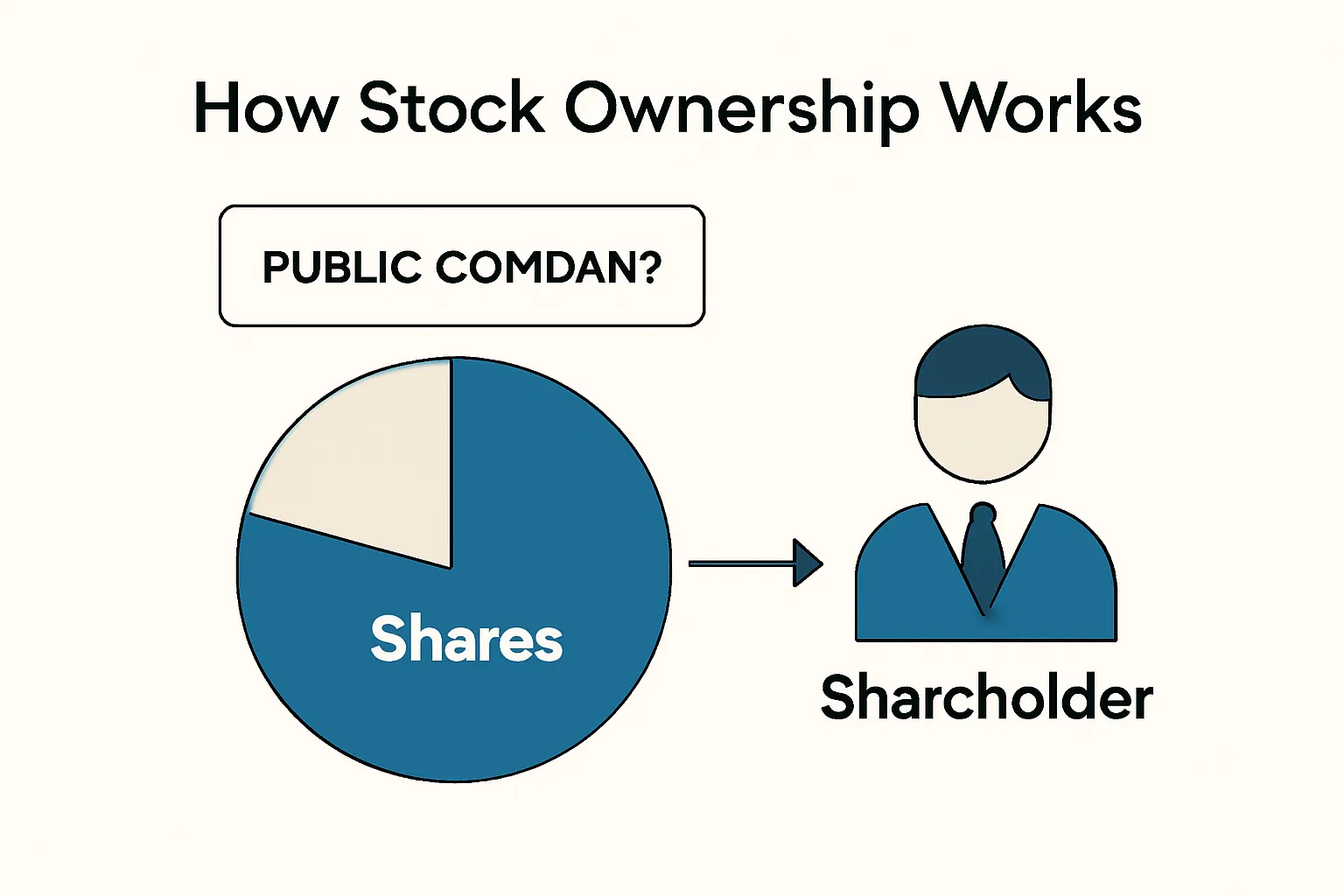
Owning a stock means you own a portion of a company—plain and simple. When a company goes public through an initial public offering (IPO), it sells shares of itself to outside investors in exchange for capital to grow the business.
These shares then trade on stock exchanges like the New York Stock Exchange or NASDAQ. Anyone—including you—can buy those shares and become a shareholder.
As a shareholder, you gain access to the company’s success and its risks. This means:
- Voting rights on company decisions (typically with common stocks)
- Potential dividends as a return on investment
- Value increases as the business grows and stock prices rise
✅ Example: Buying one share of Meta Platforms (META) makes you a partial owner of Facebook, Instagram, and WhatsApp.
But remember, ✗ if the company performs poorly, your share value could decline too. This is the nature of stock price fluctuation.
“When companies grow, so can your investment. But when they struggle, so will your return.” — CNBC Market Analyst
Want to better understand ownership? Don’t miss this breakdown: Types of Stocks: Common vs Preferred.
✅ Key Takeaway: When you buy a stock, you’re not just investing—you’re becoming a business owner, with rights and risks.
Part 3: Types of Stocks — Common vs Preferred
Not all stocks are created equal. Most beginner investors hear about stocks and think there’s only one kind, but in reality, there are two major types: common stock and preferred stock.
Here’s a quick breakdown of what each means and how they impact your investment:
| Feature | Common Stock | Preferred Stock |
|---|---|---|
| Voting Rights | ✓ Yes | ✗ No |
| Dividend Priority | ✗ Lower priority | ✓ Higher priority |
| Growth Potential | ✓ High | ✗ Limited |
| Price Stability | ✗ Less stable | ✓ More stable |
✅ Common Stock: Most investors own this type. It offers voting rights and higher growth potential, but with higher risk.
✅ Preferred Stock: Acts more like a bond—offers steady dividends and priority in case of liquidation, but little say in company decisions.
“Preferred stock is like a VIP pass to income, while common stock is a front-row seat to growth.” — Market Strategist, Fidelity
Want to learn more about different types of stock classifications? Visit our in-depth article on forms of stocks.
✅ Key Takeaway: Common stocks give you growth and a voice. Preferred stocks give you income and stability.
Part 3: Types of Stocks — Common vs Preferred
When you’re starting out as an investor, one of the most common questions is: “What’s the difference between common and preferred stock?”
These two types of equity ownership offer very different advantages. Here’s what you need to know to choose wisely:
| Feature | Common Stock | Preferred Stock |
|---|---|---|
| Voting Rights | ✓ Yes — participate in shareholder meetings | ✗ Typically none |
| Dividend Priority | ✗ Paid last, if at all | ✓ Paid before common shareholders |
| Growth Potential | ✓ High long-term returns possible | ✗ Generally lower returns |
| Volatility | ✗ Prone to bigger swings | ✓ More stable income asset |
✅ Common Stocks: Best for investors focused on long-term capital gains and growth. You may vote on company decisions and benefit more when the stock rises.
✅ Preferred Stocks: Ideal for investors seeking consistent dividend income. Less volatile, but fewer rights and less upside potential.
“Preferred stock is like a VIP pass to income, while common stock is a front-row seat to growth.” — Market Strategist, Fidelity
Want to dive deeper into stock classifications and structures? Read more on our guide to forms of stock ownership.
✅ Key Takeaway: Common = growth. Preferred = stability. Choose based on your goals, not trends.
Part 4: How Do Stocks Make Money?
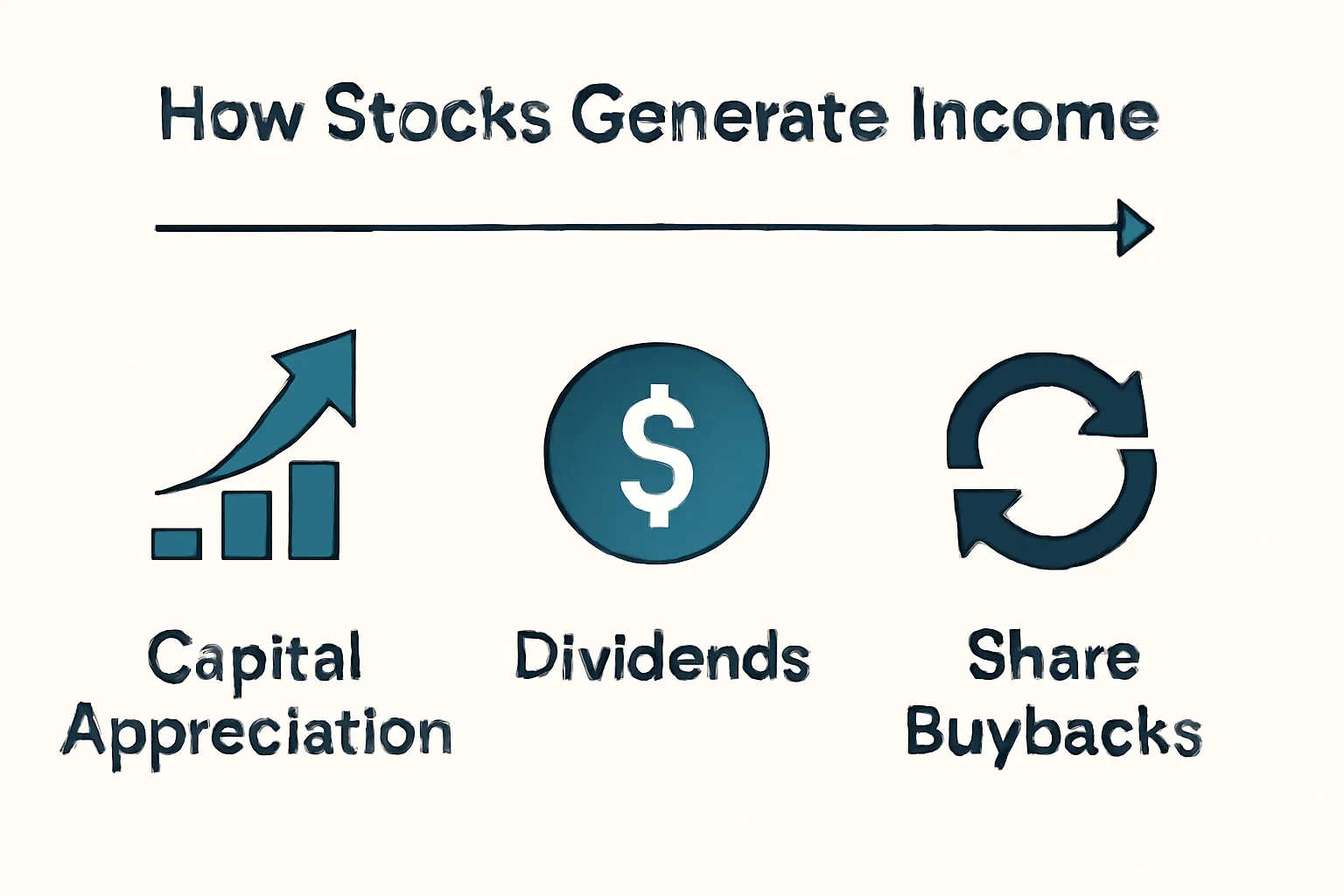
Ever wonder how do stocks gain value over time? The answer comes down to three core drivers of shareholder return:
- Capital Appreciation — The stock price goes up as the company becomes more valuable
- Dividends — Cash payouts from profits sent to shareholders
- Share Buybacks — The company buys back its own stock, increasing value per share
Capital appreciation is the most common source of return. As a company grows revenue, expands operations, or increases profit margins, the stock price tends to rise. This is what makes long-term investing so powerful—especially with companies like Nvidia, Apple, and Amazon.
Dividends are popular among income investors. Companies like PepsiCo and Johnson & Johnson have paid reliable dividends for decades, making them favorites for retirees and conservative investors.
And when a company conducts a stock buyback, it reduces the number of shares on the market, automatically increasing the value of each remaining share. This is a subtle but effective way of returning value to shareholders without paying dividends.
“Stocks make money when businesses make money. The key is owning them long enough to let compounding do its job.” — Morningstar Analyst
Looking to start making money from stocks yourself? Be sure to review our insights on dividend-based income strategies.
✅ Key Takeaway: Stocks earn returns by increasing in value and sharing profits. Your wealth grows as the company grows.
Part 5: Real-Life Example — Investing in Apple & Nvidia
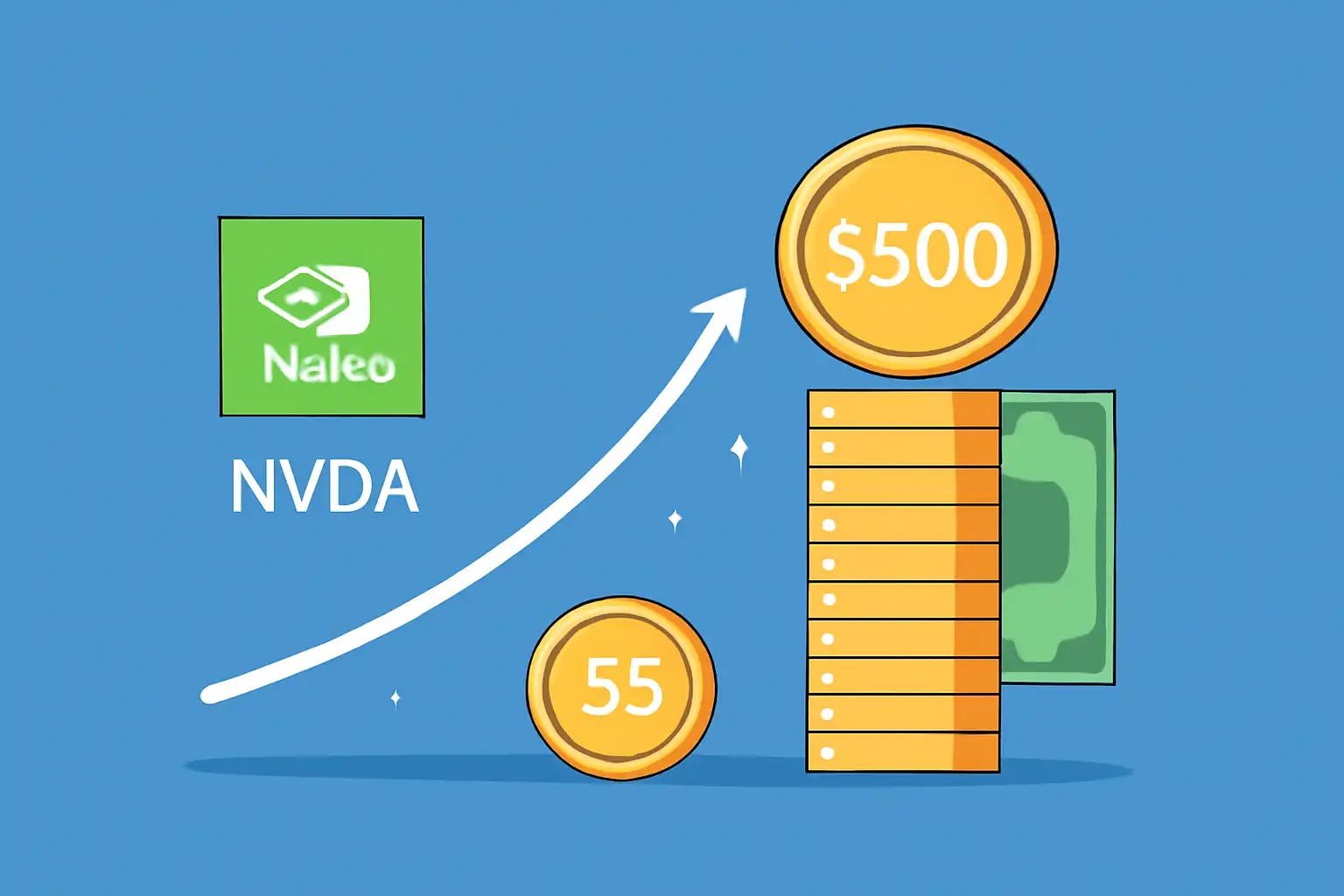
Still wondering what is a stock like Apple or Nvidia? Let’s break it down with two real-world examples that showcase how investing in stocks can grow your wealth.
🚀 Nvidia (NVDA): The AI Boom Stock
If you had invested $1,000 in Nvidia in January 2019, your investment would be worth more than $9,000 today. That’s the power of capital appreciation through AI innovation, product leadership, and market demand.
What caused Nvidia’s meteoric rise?
- Dominance in GPU chips for gaming and AI
- Massive institutional investor demand
- Positive earnings beats and strong fundamentals
✅ Key Insight: Nvidia represents a “growth stock,” with less focus on dividends and more on stock price movement.
🍎 Apple (AAPL): The Innovation Dividend King
Apple, on the other hand, is known for both steady growth and consistent dividends. While it doesn’t have the explosive gains of NVDA recently, it offers durability and income potential.
For example, if you bought $1,000 of AAPL in 2010, your shares would now be worth over $16,000—not including dividends.
Apple is also part of the Magnificent Seven stocks—alongside Meta, Amazon, Google, Tesla, Nvidia, and Microsoft—that dominate the market in 2025.
“In the stock market, time and patience create magic. Companies like Apple reward investors who wait.” — CFA Portfolio Analyst
Want to learn about more potential breakout companies? Visit our take on Tesla stock predictions.
✅ Key Takeaway: Stocks like Nvidia and Apple showcase two paths to profit: hypergrowth or long-term consistency. Diversifying across both is often the best strategy.
Part 6: Pros and Cons of Owning Stocks
While stocks are a powerful tool for building wealth, they’re not without risks. Let’s break down the major pros and cons of owning stock so you can invest with confidence and clarity.
✅ Pros of Owning Stocks
- ✓ High Return Potential — Historically, stocks offer better long-term returns than bonds, savings accounts, or CDs.
- ✓ Liquidity — Stocks can be bought and sold easily, giving you fast access to your money.
- ✓ Ownership Benefits — Shareholders may receive dividends, voting rights, and access to shareholder perks.
- ✓ Diversification — With thousands of companies to choose from, you can build a diverse, customized portfolio.
✗ Cons of Owning Stocks
- ✗ Volatility — Stock prices can swing wildly in response to news, earnings, or market sentiment.
- ✗ Emotional Decision-Making — Many investors sell too early (out of fear) or buy too late (out of greed).
- ✗ Company Risk — If the company underperforms or fails, the stock can become worthless.
- ✗ No Guaranteed Returns — Unlike bonds or savings accounts, there’s no guaranteed income from stocks.
“Stocks reward patience and punish panic. Know your risk tolerance before you invest.” — Charles Schwab Investing Guide
Need help identifying which stocks are right for you? Read our beginner-friendly post: How to Tell What Stock Is Suitable for You.
✅ Key Takeaway: Stocks can create significant wealth, but they require a cool head and a long-term mindset to avoid emotional mistakes.
Part 7: Stock Market Terms You Must Know
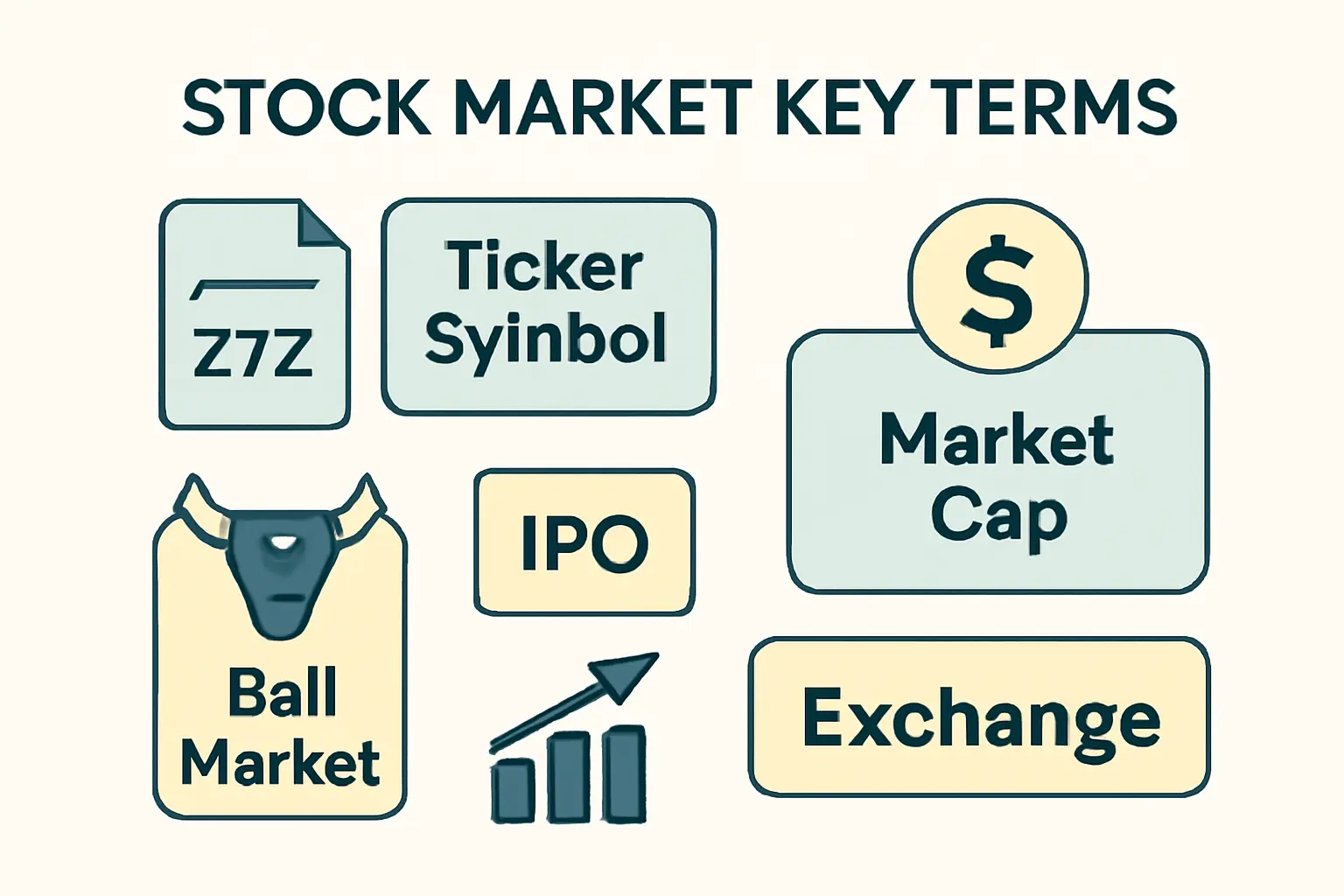
If you’re just getting started with investing, learning the right stock terms for beginners is essential. Here’s a simple glossary of must-know concepts to help you decode the financial world:
- Ticker Symbol: The unique abbreviation assigned to a company’s stock (e.g., AAPL for Apple, NVDA for Nvidia).
- Share: A single unit of ownership in a company.
- Dividend: A portion of a company’s profits paid to shareholders, typically quarterly.
- Market Capitalization (Market Cap): The total value of all a company’s shares (price × number of shares).
- P/E Ratio (Price-to-Earnings): A measure of stock price relative to company earnings; used to value a stock.
- IPO (Initial Public Offering): The first time a company’s shares become publicly available for purchase.
- Volatility: How much a stock’s price tends to fluctuate over time.
- Bull Market: A period when prices are rising or expected to rise.
- Bear Market: A period of falling prices and market pessimism.
- Portfolio: A collection of financial investments like stocks, bonds, or ETFs.
“Knowing these terms isn’t optional. It’s your first step to investing with intelligence.” — Investopedia Contributor
Still unsure how to evaluate a stock’s real value? We break it down in this detailed guide: Understanding the Real Value of a Stock.
Want more terms? Visit the full glossary at Investopedia’s stock market glossary.
✅ Key Takeaway: Learn the language of investing. The more you understand, the less risky the market feels.
Part 8: Expert Opinions on Stock Investing
Before you dive into buying your first stock, it’s wise to ask: “What do experts say about stocks and investing?” The following quotes from seasoned investors can help shape your mindset and strategy.
“The stock market is a device for transferring money from the impatient to the patient.”
— Warren Buffett, Chairman of Berkshire Hathaway
Buffett advocates long-term investing in quality businesses, not chasing trends. His track record speaks for itself. Learn more.
“Innovation gains traction during tough times.”
— Cathie Wood, CEO of ARK Invest
Wood focuses on disruptive technologies like AI, robotics, and blockchain—areas driving stocks like Nvidia and Tesla. Her thematic ETFs have reshaped growth investing. Explore ARK Invest.
“Don’t look for the needle in the haystack. Just buy the haystack!”
— Jack Bogle, Founder of Vanguard
Bogle believed in index fund investing as the simplest and safest way to build wealth. His advice is gold for new investors. Visit Vanguard.
If you want hands-on help from seasoned traders, check out our guide to finding a day trading mentor.
✅ Key Takeaway: Whether you follow Buffett’s patience, Cathie’s innovation, or Bogle’s simplicity, expert wisdom offers timeless guidance.
Part 9: Case Study — $1,000 into Tesla: Then vs Now
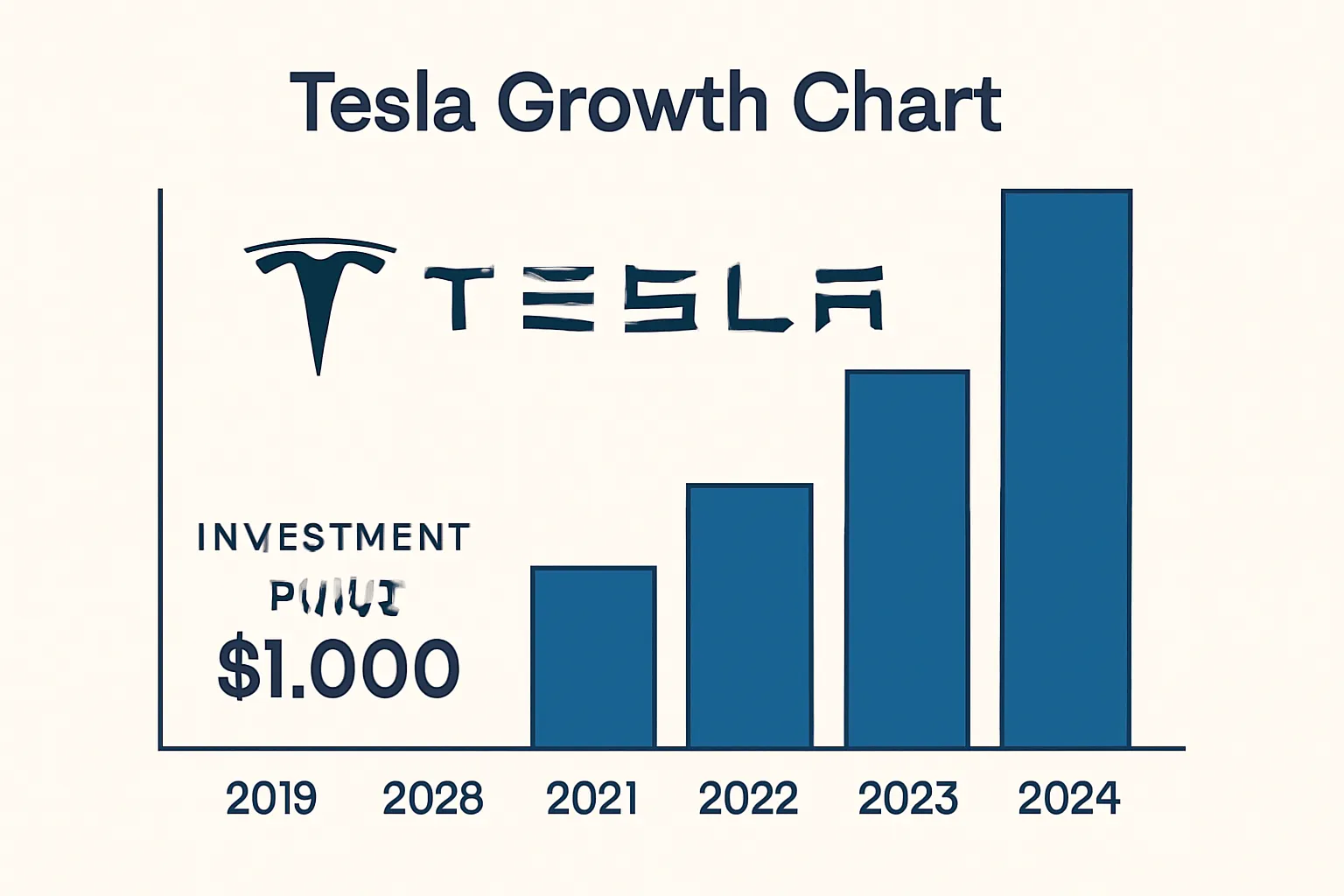
If you’ve ever wondered what happens when you invest in trending stocks, look no further than Tesla (TSLA).
📅 The $1,000 Tesla Investment Story
Back in January 2019, Tesla shares traded at a split-adjusted price of roughly $22. Fast-forward to mid-2024, and the stock trades over $300 per share.
That same $1,000 invested in 2019 would now be worth approximately $13,600 — a return of over 1,260% in just 5 years.
This remarkable growth was fueled by:
- Expansion into global EV markets (China, Europe)
- Launch of new vehicles like the Cybertruck
- Leadership in battery technology and autonomous driving
😮 What’s the Catch?
- ✗ Massive volatility: Tesla’s stock dropped over 60% during 2022.
- ✗ Emotional investing risk: Many sold early or bought too late.
- ✗ No dividends: All return came from price appreciation only.
“Trend investing works best for those who stay in through the noise — and don’t let headlines control their portfolio.” — CNBC Analyst
Interested in where Tesla might go next? Explore our Tesla stock forecast for investors.
✅ Key Takeaway: Trending stocks like Tesla can deliver massive returns—but only for those who ride the entire wave, not just the peak.
Part 9.1: Case Study — Microsoft: Growth with Stability
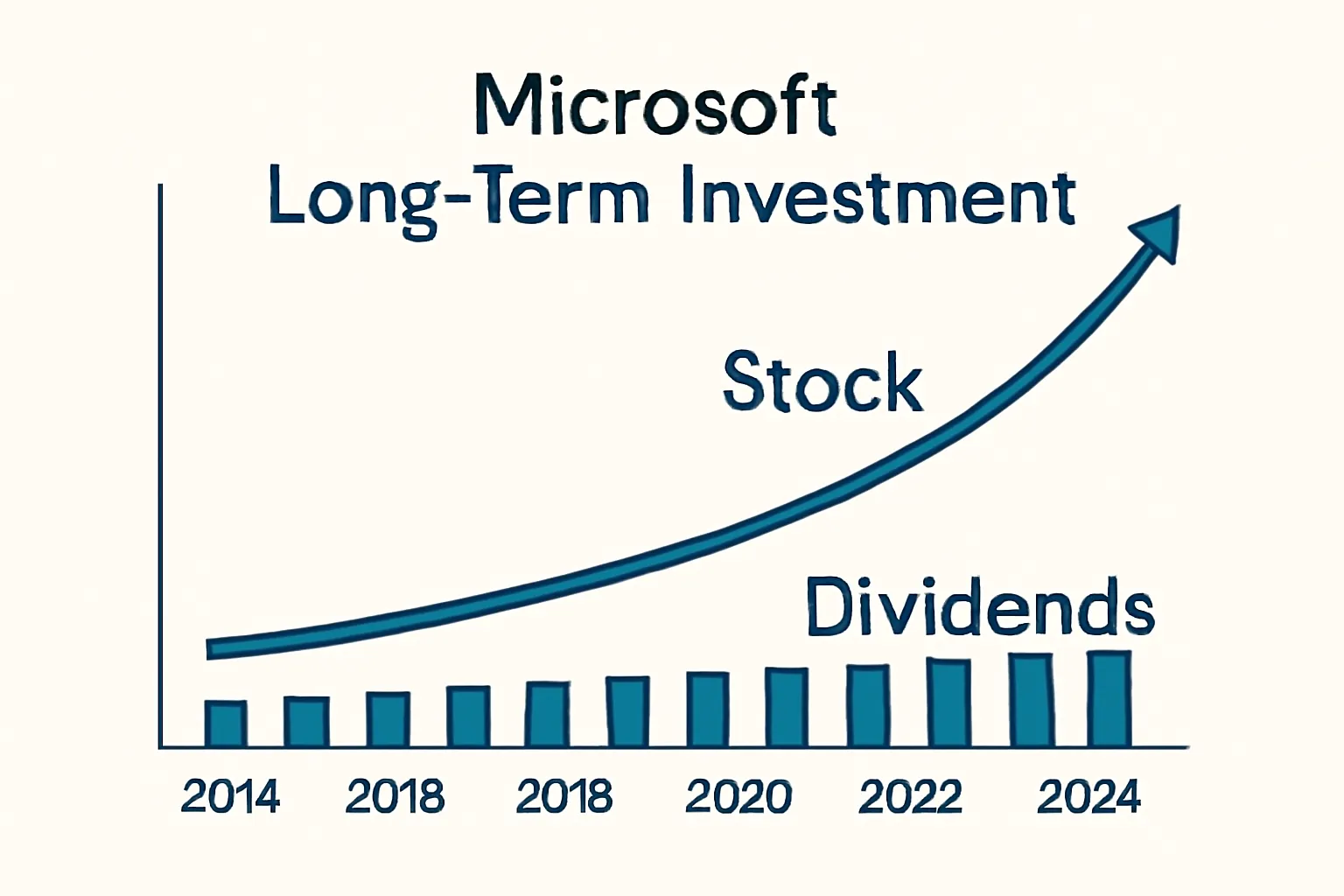
While Tesla represents a high-growth rollercoaster, Microsoft (MSFT) offers a very different kind of case study — one defined by consistency, dividends, and long-term shareholder rewards.
📈 Microsoft’s Slow and Steady Ascent
If you invested $1,000 in Microsoft stock back in 2010, your investment would now be worth over $9,000, not including reinvested dividends.
MSFT is a favorite among retirement planners and institutional investors because of its:
- Reliable dividend payouts (currently ~0.8%)
- Blue-chip status with low volatility
- Strong earnings per share (EPS) growth year after year
Unlike Tesla, Microsoft returned value through both stock appreciation and income, making it ideal for long-term holders.
⚖️ Comparison to Tesla (TSLA)
| Metric | Tesla (TSLA) | Microsoft (MSFT) |
|---|---|---|
| Volatility | High | Low to Moderate |
| Dividends | No | Yes |
| 10-Year ROI | 1,200%+ | 800%+ |
| Emotional Risk | High | Low |
“Microsoft is what happens when a great company meets long-term discipline.” — Morningstar Research
Want to see more of these success stories? Read our guide on how $100 became $1,000 in real-life stock examples.
✅ Key Takeaway: Slow and steady stocks like Microsoft may not make headlines, but they quietly build generational wealth.
Part 10: Key Takeaways + FAQ
Let’s quickly review what we’ve learned about stocks and investing. Below is a crisp summary of the most important points from this 11-part guide, followed by answers to common beginner questions.
✅ Key Takeaways
- Stocks represent ownership in a company—buying a share means you own a piece of the business.
- There are different types of stocks: common and preferred, each with their own rights and risks.
- Money is made through capital appreciation, dividends, and buybacks.
- Trending stocks like Nvidia and Tesla offer high growth, while long-term winners like Microsoft offer stability.
- Understanding terms like ticker, P/E ratio, and dividends will make you a smarter investor.
❓ Frequently Asked Questions
What is the best stock for beginners?
Look for large-cap, dividend-paying stocks with a long history of performance—such as Microsoft (MSFT) or Johnson & Johnson (JNJ). ETFs like SPY are also beginner-friendly.
Can I lose all my money in stocks?
Yes, if the company fails. But with proper diversification and long-term investing strategies, you can reduce the risk significantly.
When is the best time to buy a stock?
When the company is undervalued relative to its fundamentals—not when the market is hyped. Time in the market beats timing the market.
How much should I start investing with?
Even $100 can go a long way. Many platforms now offer fractional shares. The key is to start.
🌐 Trusted Resources for Further Learning
SEC.gov: Beginners Guide to Investing
Learn the basics directly from the U.S. Securities and Exchange Commission.
Visit SEC.gov →Investopedia: Stock Market Basics
A comprehensive glossary and educational portal for all things investing.
Visit Investopedia →Morningstar: Market Insights
Get up-to-date analysis and tools for evaluating stock investments.
Visit Morningstar →💬 Final Words
Whether you’re just starting or refining your portfolio, stocks are more than ticker symbols—they’re ownership in real businesses. Invest smart, think long-term, and always keep learning.
To get real-time trade alerts, in-depth strategies, and market insights, check out our exclusive Lion Stock Alerts service.
Bonus — 3 Ways to Build Wealth Through Ownership with Stocks
Before we wrap up this guide, there’s one more thing that’s too important to leave out. After everything we’ve covered about stocks—what they are, how they work, and how investors succeed—I’d be remiss not to mention this:
How exactly do people build real, lasting wealth through stocks? It’s not just theory. Millions have done it, and most followed just a few simple, repeatable strategies. Below are three proven ways to build wealth through ownership in the stock market.
1. 🕒 Long-Term Holding
The simplest, most powerful method is to buy high-quality companies and hold them for years—even decades. Stocks like Apple, Microsoft, and Johnson & Johnson have made thousands of people wealthy just by staying the course. Learn more about long-term investing.
Why it works: Compounding over time. As earnings grow, the stock value increases—and so does your share of the company.
“The stock market is designed to transfer money from the active to the patient.” — Warren Buffett
2. 💸 Dividend Reinvestment
When companies pay dividends and you reinvest them, you’re using your earnings to buy more shares—which then earn more dividends. That’s compound growth in action. Stocks like Coca-Cola, Procter & Gamble, and PepsiCo have raised their dividends for decades, rewarding long-term holders generously. Read more about Dividend Reinvestment Plans (DRIPs).
Most brokerages allow automatic dividend reinvestment, called a DRIP (Dividend Reinvestment Plan).
3. 📅 Dollar-Cost Averaging (DCA)
Instead of trying to guess the best time to buy, Dollar-Cost Averaging involves investing a fixed amount on a regular schedule—no matter what the market is doing. Learn more about Dollar-Cost Averaging (DCA).
DCA removes emotion and helps reduce the risk of buying at the wrong time. Over time, your average cost balances out, and you stay consistent in building wealth.
📊 Summary Table: Wealth-Building Strategies
| Strategy | How It Builds Wealth | Best For |
|---|---|---|
| Long-Term Holding | Compounding returns over many years | All investors with patience |
| Dividend Reinvestment | Generates more shares with no new cash | Passive and income-focused investors |
| Dollar-Cost Averaging | Reduces risk from market timing errors | New and disciplined investors |
✅ Final Takeaway: Don’t just own stock—own with purpose. These three strategies have helped ordinary investors turn small amounts into generational wealth. Learn more about building wealth.